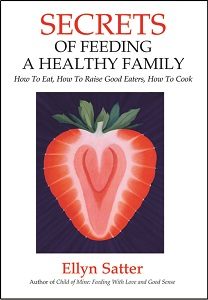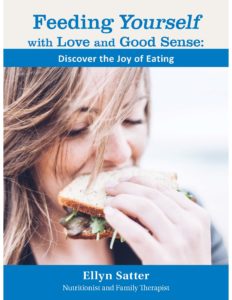

Family Meals Focus
The Ellyn Satter Institute Newsletter
Versions of internally regulated eating
by Ellyn Satter, MS, MSSW, Dietitian and Family Therapist
For a PDF of this newsletter, click here
Growing out of your own or others’ misery about eating and weight, are you among the many dietitians/ health professionals shifting your practice from prescription and control to acceptance and trust? You might use defined and established approaches, such as the Satter Eating Competence Model (ecSatter), Intuitive Eating (IE), or nonspecific approaches1-3 such as Health at Every Size (HAES), non-dieting, mindful eating (ME), or “intuitive eating” (e.g. generic description that can encompass non-dieting, HAES, and ME).4-6 Or you might use an eclectic mix that you have created or gleaned from others, such as psychoeducation and persuasion. Subjects who score high on ecSI 2.0 or IES 2 score relatively high on biological and psychosocial indicators and show lower BMIs.7, 8 Those who indicate internally regulated eating in unvalidated testing show improved psychological health4, 5 and lower odds of chronic dieting and binge eating.5, 6
What do internally regulated eating practices have in common?
Interventions that heal eating attitudes and behaviors have this in common:
- Are food neutral: Give strong permission to eat preferred food, without in any way stipulating “healthy” or “unhealthy” food.
- Support internally regulated eating: Give strong permission to eat as much as is wanted based on hunger, appetite, and satiety.
- Are weight neutral: Give strong acceptance of weight.
- Incorporate positive discipline: In the context of strong permission to eat, manage the eating environment to allow paying attention to self and eating.
Consider research
Let’s face it: Research is the only way to change policy and stop this epidemic of misery about eating and weight. For convincing research, an intervention has to be based on grounded theory,9 be so clearly and concretely defined that someone else can reproduce it, and be supported by data. The use of validated instruments for before-and-after testing raises effectiveness evaluation from subjective (and possibly biased) clinical observation to objective assessment. ecSatter is concretely described,1 reproducible,10, 11 has a validated test, ecSI 2.0,2 and is supported by outcome data.10, 11 Intuitive Eating lays out general principles and practice in a self-help lay publication;12 those principles are given objective support by being used as the basis for a validated test, IES 2.0.13 The other approaches are variously and often vaguely defined.
Using ecSI 2.0 or IES 2.0
Can ecSI 2.0 or IES 2.0 be used for before-and-after testing of nonspecific or eclectic approaches? Before-and-after testing, yes. Both have been tested for reliability. Capturing changes, maybe. Getting permission to use the tools aside, ecSI 2.0 or IES 2.0 may or may not capture the changes brought about by your intervention. Here is what each inventory addresses:
- ecSatter’s four components: context management, positive attitudes, internal regulation, and food acceptance.
- Intuitive Eating eschews structure and measures unconditional permission to eat, eating for physical rather than emotional reasons, and relying on internal hunger/satiety cues.
Consider your stance on emotional eating
Do you regard all emotional eating as negative and obesogenic? Do you take the IE perspective that emotional eating causes weight gain and that identifying underlying issues and preventing emotional eating will produce weight loss? Or do you take the ecSatter perspective that emotional eating is normal and legitimate? ecSatter gives permission to eat for emotional reasons and, in the context of the permission and discipline of Competent Eating, emotional eating does not disrupt energy homeostasis.
Consider your stance on structure
Do you see structure as critical? Or do you regard structure as substituting external rules for inner experience and therefore being tantamount to restriction? The former would be ecSatter, the latter, IE. Research contradicts the notion that structure breeds restraint, as high ecSI 2.0 scores correlate with low scores on cognitive restraint14-16 and restrained feeding.16 Parents who score high on sDOR.2-6y also score high on ecSI 2.0, and do particularly well with context.16 Consistent meals and snacks are the backbone of both ecSatter and sDOR.
Consider your stance on nutritional guidance
Can you address nutrition and food selection without taking away permission to eat preferred food? Or do you avoid discussing it at all? Nutritional excellence is an integral component of ecSatter.17, 18 Working with ecSatter, food selection is addressed in the context of meal-building, giving strong permission to eat preferred foods. Growing out of the positive meal habit, as described by the Satter Hierarchy of Food Needs,6 adults experientially evolve Eating Competence, food security, food variety, and dietary quality.19 14, 15, 20-22 IE encourages gentle nutrition: “In matters of taste, consider nutrition; in matters of nutrition, consider taste.”12
Consider your clarity
Can you be so clear and concrete in describing your intervention that others can do what you do? How do you educate and address uncomplicated eating issues? How do you treat established problems?
- ecSatter addresses uncomplicated eating issues with counseling guidance23 and published self-help information.24, 25 ecSatter assesses and treats10, 11 complicated and established issues with the “How to Eat” method,26which restores positive eating attitudes and behaviors using a variety of evidence-based cognitive-behavioral techniques such as relaxation and desensitization training.
- For eating problems in general as well as in clinical intervention, IE utilizes flooding: encouraging access to unlimited amounts of “forbidden” foods until the foods’ fear potential is neutralized. IE utilizes in-session teaching, discussion, and encouragement to replace negative eating attitudes and behaviors with positive ones.12
Make your decision
It is certainly up you, the clinician, whether you use a loosely described intervention or one that is “research-ready.” It all comes down to whether you are willing to clearly define your intervention, test it, and accumulate data. It all represents a lot of work, and not everyone enjoys it! ESI Faculty Member Cristen Harris can help. She does training on doing clinical research27 and can compile your ecSatter-based data with that of others and help get your contribution into print.
References
- Mensinger JL, Calogero RM, Stranges S, et al. A weight-neutral versus weight-loss approach for health promotion in women with high BMI: A randomized-controlled trial. Appetite. 2016;105:364-374.
- Bacon L. Health at Every Size: The Surprising Truth About Your Weight. BenBella Books; 2008.
- Schaefer JT, Magnuson AB. A review of interventions that promote eating by internal cues. J Acad Nutr Diet. May 2014;114(5):734-60.
- Van Dyke N, Drinkwater EJ. Relationships between intuitive eating and health indicators: literature review. Public Health Nutr. 2014;17:1757-1766.
- Hazzard VM, Telke SE, Simone M, et al. Intuitive eating longitudinally predicts better psychological health and lower use of disordered eating behaviors: findings from EAT 2010-2018. Eat Weight Disord. 2021;26:287-294.
- Denny KN, Loth K, Eisenberg ME, et al. Intuitive eating in young adults. Who is doing it, and how is it related to disordered eating behaviors? Appetite. 2013/01/01/ 2013;60:13-19.
- Camilleri GM, Méjean C, Bellisle F, et al. Intuitive eating is inversely associated with body weight status in the general population-based NutriNet-Santé study. https://doi.org/10.1002/oby.21440. Obesity. 2016/05/01 2016;24:1154-1161.
- Satter E. The Satter Eating Competence Model: the Satter approach to eating ESI Accessed August 27, 2021. https://www.ellynsatterinstitute.org/satter-eating-competence-model/
- Johansson CB. Introduction to qualitative research and grounded theory. International Body Psychotherapy Journal. 2019;18:94-99.
- Harris C, Crum P, Satter E. Feasibility of Satter’s How to Eat Method Using Two Delivery Modes to Improve Eating Competence Among Previous Dieters in a University Employee Wellness Program. Current Developments in Nutrition. 2020;4(Supplement_2):1306-1306.
- Harris C, Estes P, Satter E. Feasibility of Using Satter’s How to Eat Method to Improve Eating Competence Among Previous Dieters in a Metropolitan Hospital System Employee Wellness Program. Current Developments in Nutrition. 2020;4(Supplement_2):1307-1307.
- Tribole E, Resch E. Intuitive Eating; A revolutionary program that works. St. Martin’s Griffin; 2020.
- Tylka TL, Kroon Van Diest AM. The Intuitive Eating Scale-2: item refinement and psychometric evaluation with college women and men. J Couns Psychol. 2013;60:137-153.
- Lohse B, Satter E, Horacek T, et al. Measuring eating competence: psychometric properties and validity of the ecSatter Inventory. J Nutr Educ Behav. 2007;39:S154-S166.
- Krall JS, Lohse B. Validation of a measure of the Satter eating competence model with low-income females. Int J Behav Nutr Phys Act. 2011;8:26-36. doi:10.1186/1479-5868-8-26 PMC3094263,
- Lohse B, Mitchell DC. Valid and reliable measure of adherence to Satter Division of Responsibility in Feeding. J Nutr Educ Behav. 2021:211-222.
- Satter E. Nutrition education with the Satter Eating Competence Model. J Nutr Educ Behav. 2007;39:S189-S194.
- Satter E. Eating Competence: definition and evidence for the Satter Eating Competence Model. J Nutr Educ Behav. 2007;39:S142-S153.
- Satter E. Hierarchy of food needs. J Nutr Educ Behav. 2007;39:S187-S188.
- Tilles-Tirkkonen T, Aittola K, Männikkö R, et al. Eating Competence Is associated with lower prevalence of obesity and better insulin sensitivity in Finnish adults with increased risk for type 2 diabetes: The StopDia Study. Nutrients. 2019;12. doi:10.3390/nu12010104 PMC7019577,
- Lohse B, Pflugh Prescott M, Cunningham-Sabo L. Eating Competent parents of 4th grade youth from a predominantly non-Hispanic white sample demonstrate more healthful eating behaviors than non-eating competent parents. Nutrients. 2019;11. doi:10.3390/nu11071501 PMC6682872,
- Lohse B, Bailey RL, Krall JS, et al. Diet quality is related to eating competence in cross-sectional sample of low-income females surveyed in Pennsylvania. Appetite. 2012;58:645-650.
- Satter E. Family Meals Focus #28: Counseling with the Satter Eating Competence Model. Accessed May 20 2021. https://ellynsatterinstitute.org/family-meals-focus/28-counseling-with-eating-competence/
- Satter EM. Section 1: How to eat Secrets of Feeding a Healthy Family. Kelcy Press; 1999. https://www.ellynsatterinstitute.org/product/secrets/
- Satter E. Feeding Yourself with Love and Good Sense. Kelcy Press; 2020. https://www.ellynsatterinstitute.org/product/feeding-yourself-with-love-and-good-sense-grouped/
- Satter EM. Treating the Dieting Casualty: Intensive Workshop on Treating the Chronic Dieter. Ellyn Satter Institute. Accessed April 27, 2021, https://www.ellynsatterinstitute.org/education/workshops-keynotes/treating-the-dieting-casualty-vision-workshop/
- Harris C. ESI webinar. Researching Satter: Strengthening the Evidence-Base for the Satter Models. Accessed May 20, 2021, https://www.ellynsatterinstitute.org/product/prof-web-evidence/
Explore
Ellyn Satter’s Secrets of Feeding a Healthy Family says the secret of raising a healthy eater is to love good food, enjoy eating, and share that love and enjoyment with your child. When the joy goes out of eating, nutrition suffers.


